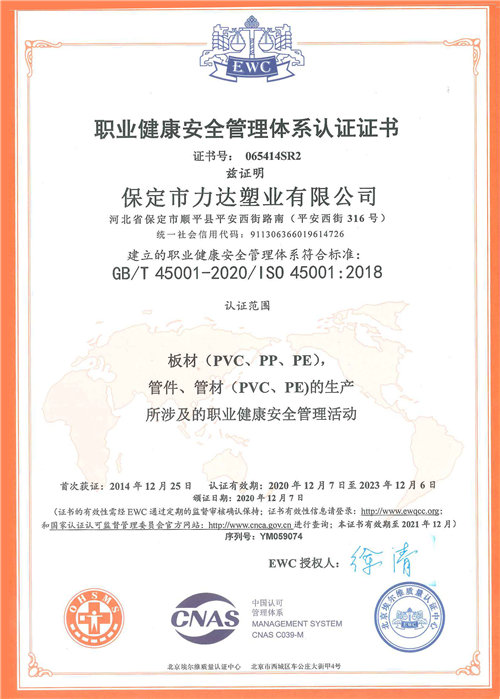Oct . 14, 2024 20:43 Back to list
High-Density Polyethylene Pipes for Efficient Drainage Systems and Solutions
Understanding HDPE Drainage Pipes A Comprehensive Overview
High-Density Polyethylene (HDPE) drainage pipes have become a popular choice in modern civil engineering and construction projects. This material, known for its durability and flexibility, is increasingly utilized for various drainage applications ranging from residential to commercial and industrial uses. In this article, we will explore the features, benefits, installation methods, and various applications of HDPE drainage pipes.
What is HDPE?
HDPE is a type of thermoplastic polymer made from petroleum. It is known for its high strength-to-density ratio which provides a robust solution for drainage needs. HDPE pipes are manufactured through an extrusion process, creating a pipe that is lightweight yet extremely durable, making it easy to transport and install.
Key Features of HDPE Drainage Pipes
1. Durability HDPE pipes are resistant to corrosion, chemicals, and environmental stressors, making them suitable for various conditions. Unlike traditional materials like concrete or steel, HDPE doesn’t rust or degrade over time, ensuring longevity and reliability.
2. Flexibility The flexibility of HDPE allows the pipes to be installed in challenging underground conditions. Unlike rigid pipes, HDPE can bend without breaking, accommodating shifts in the soil and other ground materials.
3. Lightweight Compared to conventional materials, HDPE pipes are considerably lighter, which simplifies the handling and installation processes. Their ease of installation contributes to reduced labor costs and shorter project timelines.
4. Cost-Effectiveness Although initially more expensive than some alternatives, the long-term cost savings provided by HDPE pipes often outweigh the upfront investment. Their durability minimizes the need for frequent replacements or repairs, resulting in reduced maintenance costs.
5. Environmental Benefits HDPE is recyclable, making it an eco-friendly choice. The material can be reused in various applications, contributing to a more sustainable construction industry.
Installation of HDPE Drainage Pipes
hdpe drainage pipe

The installation of HDPE drainage pipes requires careful consideration of a few factors to ensure optimal performance
1. Site Preparation Before installation, the site must be prepared, which includes clearing any obstructions and grading the area to facilitate proper drainage.
2. Trenching A trench must be excavated at the appropriate depth and width to accommodate the diameter of the pipe. Proper trench depth is crucial to prevent excessive pressure that can lead to pipe deformation.
3. Pipe Joining HDPE pipes can be joined through several methods, including butt fusion, electrofusion, and mechanical fittings. Butt fusion, where the ends of two pipes are heated and pressed together, is commonly used for permanent joints.
4. Backfilling After the pipes are installed, the trench is backfilled with the excavated material. Care must be taken to avoid damaging the pipes, and the backfill should be compacted to support the pipe structure.
Applications of HDPE Drainage Pipes
HDPE drainage pipes are versatile and can be utilized across a wide spectrum of applications
- Stormwater Management They effectively transport stormwater, reducing the risk of flooding and erosion in urban areas. - Sewage and Wastewater In sanitation systems, HDPE pipes are ideal for carrying sewage and treated recycled water. - Agricultural Drainage Farmers can utilize HDPE pipes for subsurface drainage, enhancing crop yields by managing excess water. - Industrial Applications Industries often require robust drainage solutions for managing wastewater and runoff, where HDPE pipes serve as a reliable option.
Conclusion
In summary, HDPE drainage pipes represent a significant advancement in the construction and civil engineering sectors. With their exceptional durability, flexibility, and cost-effectiveness, they meet the diverse needs of modern drainage systems. As sustainability becomes increasingly crucial in construction practices, HDPE pipes provide an eco-friendly alternative that aligns with these goals. Whether used in residential projects, industrial settings, or agricultural applications, HDPE drainage pipes are an essential component of effective and efficient water management systems. Their ongoing adoption marks a positive shift toward more innovative and sustainable infrastructure solutions.
-
PVC Transparent Sheet Roll - Durable & Flexible PVC Plastic Sheet Roll for Industrial & Home Use
NewsJun.24,2025
-
High-Quality PVC PPR Pipes and Fittings Durable ERA PPR Solutions
NewsJun.10,2025
-
High-Quality Large HDPE Sheets & Large Diameter PVC Pipe Durable Large PVC Pipe Supplier
NewsJun.10,2025
-
High Density Polyethylene Cutting Board - Durable & Food Safe
NewsJun.09,2025
-
3 Inch PVC Pipe for Durable Irrigation Affordable & Reliable
NewsJun.09,2025
-
Premium PPR Plastic Water Pipe Fittings - Durable & Leak-Free
NewsJun.09,2025

